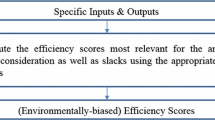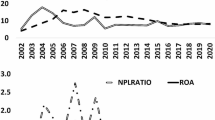Abstract
The primary objective of the article is to illustrate how to develop a multiple stakeholder perspective (MSP) on a common set of financial ratios using a cross-country survey and reflect this information in a single comparative bank performance estimate. Data Envelopment Analysis brings together the varying perspectives of five key stakeholders, namely, regulators, shareholders, customers, bank managers and employees. I develop the MSP approach by taking advantage of a recent online survey of stakeholder perceptions on key financial ratios across the major trading partners Australia, China and Japan. Insights gained through MSP can guide regulatory vigor, promotional or public relations activities, raising of equity capital in overseas markets and other cross-border operations such as positioning an institution’s international presence in a host country.

Similar content being viewed by others
Notes
On 8 July 2014 Australia and Japan signed an economic partnership agreement, and Australia and China signed a free trade agreement on 17 November 2014.
References
Andersen, P., & Petersen, N. C. (1993). A procedure for ranking efficient units in data envelopment analysis. Management Science, 39, 1261–1264.
Avkiran, N. K. (1999). The evidence on efficiency gains: The role of mergers and the benefits to the public. Journal of Banking and Finance, 23, 991–1013.
Avkiran, N. K. (2000). Rising productivity of Australian trading banks under deregulation 1986–1995. Journal of Economics and Finance, 24, 122–40.
Avkiran, N. K. (2006). Developing foreign bank efficiency models for DEA grounded in finance theory. Socio-Economic Planning Sciences, 40, 275–296.
Avkiran, N. K. (2009). Removing the impact of environment with units-invariant efficient frontier analysis: An illustrative case study with intertemporal panel data. OMEGA—The International Journal of Management Science, 37, 535–544.
Avkiran, N. K. (2011). Association of DEA super-efficiency estimates with financial ratios: Investigating the case for Chinese banks. OMEGA—The International Journal of Management Science, 39, 323–334.
Avkiran, N. K., & Mizuno, M. (2013). Stakeholder perspectives on bank performance: A preliminary survey across Australia, China and Japan. JASSA (The Finsia Journal of Applied Finance), Winter(Issue 2), 30–35.
Avkiran, N. K., & Morita, H. (2010). Benchmarking firm performance from a multiple-stakeholder perspective with an application to Chinese banking. OMEGA—The International Journal of Management Science, 38, 501–508.
Avkiran, N. K., & Thoraneenitiyan, N. (2010). Purging data before productivity analysis. Journal of Business Research, 63(3), 294–302.
Avkiran, N. K., & Turner, L. (1996). Upward evaluation of branch manager’s competence: How to develop a measure in-house. Asia-Pacific Journal of Human Resources, 34(3), 37–47.
Avkiran, N. K., & Zhu, Y. (forthcoming in 2016). Pitching DEA against SFA in the context of Chinese domestic versus foreign banks. In the book by Springer entitled. Handbook of operations analytics using data envelopment analysis.
Banker, R. D., & Natarajan, R. (2008). Evaluating contextual variables affecting productivity using data envelopment analysis. Operations Research, 56(1), 48–58.
Banker, R. D., Charnes, A., & Cooper, W. W. (1984). Some models for estimating technical and scale inefficiencies in data envelopment analysis. Management Science, 30, 1078–1092.
Bartlett, C. A., & Ghoshal, S. (1998). Beyond strategic planning to organizational learning: Lifeblood of the individualized corporation. Strategy and Leadership, 26, 34–39.
Bhattacharyya, A., Lovell, C. A. K., & Sahay, P. (1997). The impact of liberalization on the productive efficiency of Indian commercial banks. European Journal of Operational Research, 98, 332–45.
Brockett, P. L., Charnes, A., Cooper, W. W., Huang, Z. M., & Sun, D. B. (1997). Data transformations in DEA cone ratio envelopment approaches for monitoring bank performances. European Journal of Operational Research, 98, 250–68.
Charnes, A., Cooper, W. W., & Rhodes, E. (1978). Measuring the efficiency of decision making units. European Journal of Operational Research, 2, 429–444.
Charnes, A., Cooper, W. W., & Rhodes, E. (1981). Evaluating program and managerial efficiency: An application of data envelopment analysis to program follow through. Management Science, 27, 668–697.
Coelli, T. J., Prasada, R. D. S., O’Donnell, C. J., & Battese, G. E. (2005). An introduction to efficiency and productivity analysis (2nd ed.). New York: Springer.
Cook, W., & Zhu, J. (2010). Context-dependent performance standards in DEA. Annals of Operations Research, 173, 163–175.
Cooper, W. W., Park, K. S., & Pastor, J. T. (2001). The range adjusted measure (RAM) in DEA: A response to the comment by Steinmann and Zweifel. Journal of Productivity Analysis, 15, 145–152.
Cooper, W. W., Ruefli, T. W., Deng, H., Wu, J., & Zhang, Z. (2008). Are state-owned banks less efficient? A long- vs. short-run data envelopment analysis of Chinese Banks. International Journal of Operational Research, 3, 533–556.
Cooper, W. W., Seiford, L. M., & Tone, K. (2007). Data envelopment analysis: A comprehensive text with models, applications, references and DEA-Solver software (2nd ed.). New York: Springer.
Cooper, W. W., Seiford, L. M., & Zhu, J. (2011). Handbook on data envelopment analysis (2nd ed.). Massachusetts: Kluwer Academic Publishers, Norwell.
Garcia-Cestona, M., & Surroca, J. (2008). Multiple goals and ownership structure: Effects on the performance of Spanish savings banks. European Journal of Operational Research, 187, 582–599.
Gelade, G., & Gilbert, P. (2003). Work climate and organizational effectiveness: The application of data envelopment analysis in organizational research. Organizational Research Methods, 6, 482–501.
Greenley, G. E., & Foxall, G. R. (1997). Multiple stakeholder orientation in UK companies and the implications for company performance. Journal of Management Studies, 34, 259–84.
International Monetary Fund. (2011). People’s Republic of China: Financial system stability assessment, IMF Country report no. 11/321.
KPMG. (2007). Retail banking in China: New frontiers. March, Hong Kong.
Llewellyn, D. T. (2005). Competition and profitability in European banking: Why are British banks so profitable? Banca Monte dei Paschi di Siena, 34(3), 279–311.
London, M., & Smither, J. W. (1995). Can multi-source feedback change perceptions of goal accomplishment, self-evaluations and performance related outcomes? Theory Based Applications and Directions for Research, Personnel Psychology, 48, 803–839.
Lozano, S., & Villa, G. (2010). Gradual technical and scale efficiency improvement in DEA. Annals of Operations Research, 173, 123–136.
Miller, S. M., & Noulas, A. G. (1996). The technical efficiency of large bank production. Journal of Banking and Finance, 20, 495–509.
Olesen, O. B., Petersen, N. C., & Podinovski, V. V. (2015). Efficiency analysis with ratio measures. European Journal of Operational Research, 245, 446–462.
PricewaterhouseCoopers. (2008). Foreign banks in China. June, Hong Kong.
Regional Banks Association of Japan. (2011). Regional banks in Japan. March 31.
Sturm, J. E., & Williams, B. (2004). Foreign bank entry, deregulation and bank efficiency: Lessons from the Australian experience. Journal of Banking and Finance, 28, 1775–1799.
Sueyoshi, T., & Sekitani, K. (2009). An occurrence of multiple projections in DEA-based measurement of technical efficiency: Theoretical comparison among DEA models from desirable properties. European Journal of Operational Research, 196, 764–794.
Tone, K. (2001). A slacks-based measure of efficiency in data envelopment analysis. European Journal of Operational Research, 130, 498–509.
Tone, K. (2002). A slacks-based measure of super-efficiency in data envelopment analysis. European Journal of Operational Research, 143, 32–41.
Tone, K., & Tsutsui, M. (2010). Dynamic DEA: A slacks-based measure approach. OMEGA—The International Journal of Management Science, 38(3–4), 145–156.
Yang, X., & Morita, H. (2013). Efficiency improvement from multiple perspectives: An application to Japanese banking industry. OMEGA—The International Journal of Management Science, 41(3), 501–509.
Acknowledgments
I would like to thank Professor Ali Emrouznejad for managing the submission and the anonymous referees for encouraging me to revise the original submission.
Author information
Authors and Affiliations
Corresponding author
Appendix
Appendix
See Table 7.
Rights and permissions
About this article
Cite this article
Avkiran, N.K. An illustration of multiple-stakeholder perspective using a survey across Australia, China and Japan. Ann Oper Res 248, 93–121 (2017). https://doi.org/10.1007/s10479-016-2191-7
Published:
Issue Date:
DOI: https://doi.org/10.1007/s10479-016-2191-7




